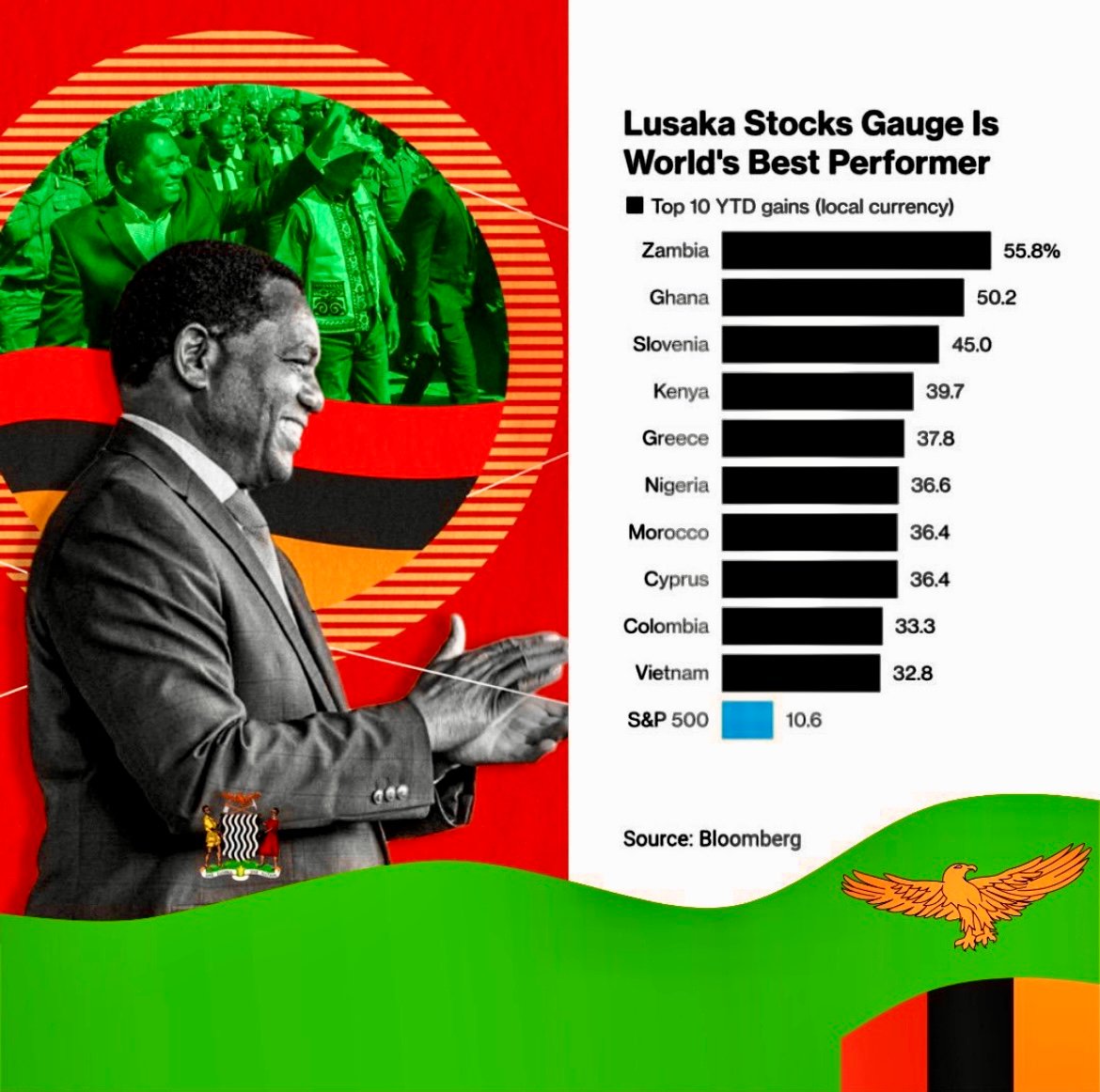Zambia’s Lusaka Stock Exchange (LuSE) is basking in global market glory, having recorded phenomenal growth in the past year. However, a serious disconnect between these headline numbers and national wellbeing lurks beneath the surface.
LuSE All-Share Index recorded a 55.8% year-to-date nominal gain in local currency (Zambian Kwacha, ZMW) as of mid-2025. Very commendable, but this reflects sector-specific appreciations in a limited set of publicly listed companies, rather than being a reflection of broad economic vitality. The country’s economy's nominal GDP growth in 2024 was 4%, albeit amid drought impacts and debt restructuring.
When adjusted for average 12% inflation this year the Exchange yields an impressive real gain above approximately 38%, unlike real economic gains from net exports that appreciated a paltry 4% in local terms. These headline gains beckon international investors and fill local fund managers with pride, but the unsentimental economist must ask: what do they actually reveal about the lives and fortunes of ordinary Zambians?
First, one must know that most market euphoria is generated by a cluster of giants, not by system-wide expansion. The LuSE, with 20 listed companies and a market capitalisation of ZMW 276.7 billion (US$9.8 billion) as of April 2025, achieved top global performance in local currency terms, driven by fortunes of a handful of companies. These chosen companies were buoyed by recoveries in mining and utilities sectors post-debt restructuring.
As one notes, this contrasts with Zambia's economy facing a historic drought, with real GDP growth expected to slow to 1.2% in 2025 from 5.6% average in 2021–2023, as per World Bank projections. When drought turns harvests to dust and GDP growth to a crawl, a roaring exchange can be a mirage born of optimism in a few boardroom, not bounty in the whole marketplace.
For all its global acclaim, the LuSE is built atop a narrow economic base, easily sideswiped by shocks to its leading firms. In 2024, Zambia's economy, as defined by aggregate demand components in the expenditure approach to GDP, comprised household consumption at approximately 60% of GDP in 2024 (down from prior trends due to drought-induced food price pressures), gross fixed capital formation at 25% supported by mining investments, government expenditure at 18% of GDP with net domestic financing capped at 0.7% amid fiscal consolidation, and net exports broadly unchanged as stronger copper exports offset weaker non-traditional goods, contributing positively at 5% of GDP.
Total nominal GDP stood at US$26.33 billion, equivalent to ZMW 696.1 billion at average exchange rate of ZMW 26.45/USD. This is the base we are working with. But when consumer confidence, government outlays, and basic investment grind down, while only copper lifts GDP, can share price gains on the main bourse alone lift the economic tide?
As alluded to earlier, only a handful of companies dominates the LuSE — to the exclusion of the lived experience of most Zambians. The LuSE's composition reveals limited representation, with top weightings dominated by these few: Copperbelt Energy Corporation (CEC) at approximately 25% of market cap (price ZMW 25.95 as of August 2025), British American Tobacco Zambia (BATZ) at 15% (price ZMW 12.96), Airtel Networks (ATEL) at 12%, and mining-linked entities like First Quantum Minerals (FQM) at 10%, collectively accounting for a whooping 60% of the index.
This concentration underscores the stock market's narrow scope, excluding small businesses, which are 99% of Zambian firms by count, employing 50% of workforce and informal sectors. This then leaves a stock exchange so top-heavy that likely exposes itself, and the country, to the whims of a few boardrooms rather than a national economy’s strength.
Then there is that fortunes of these mentioned companies can soar, thanks to outliers, even as most of the economy remains grounded, yet it may (and in this case is) not mirrored in the wider economy. LuSE concentration suggests moderate dominance, unlike the diversified S&P 500, to use an apex benchmark. Thus, company appreciations are individual wins, and there is need of enough of them to do so for the aggregated success to be impactful to the whole economy.
In the case of Zambia, CEC surged 35% in H1 2025 on energy sector reforms, BATZ +231.46% YTD through August 2025 from tobacco export gains, ATEL +15% on telecom expansions, and FQM +20% amid copper price recoveries to US$9,500/ton; these nominal ZMW gains (e.g., BATZ from ZMW 3.91 to 12.96, +231.46%) adjust to real terms at +194.3% after 12.6% August 2025 inflation. All these represented firm-specific efficiencies rather than Zambia-wide growth, indirectly benefiting the economy via 2% employment in listed sectors but not alleviating 14.8% unemployment recorded across the country. So we can see that despite these top tier company victories, widespread prosperity remains elusive.
Also to be considered is that speculation, not broad-based economic dynamism, often drives most dizzying returns in stock markets, just as quickly, the narrative may turn as well. While forward-looking stock valuations incorporate speculation, GDP metrics are backward looking. If all Zambia’s hopes rest on copper prices and a few winners, the risk is that both market optimism and national outlook can evaporate just as swiftly.
The real economy, then, unlike the stock market, is lived, distributed, and uneven, while being subject to inflation, currency swings, and the limits of fiscal firepower. Additionally, real economic gains, like net exports (copper exports US$8.5 billion in 2024) appreciate in ZMW terms during depreciation, boosting fiscal revenues by 10–15% nominally per 10% ZMW weakening, yielding multipliers around 1.4. No such multipliers can be derived with a depreciation in the exchange market. So a win is for individual companies, while their loss of value thereon is to be defended by the whole economy.
For ordinary Zambians, these headline market stories rarely trickle down, highlighting sharp wealth divides and persistent unemployment. Wealth inequality exacerbates the disconnect: top 10% own 80% of stocks, anyway, per Gini-adjusted metrics, limiting trickle-down from the gains. When most workers remain uninvested and unrepresented by the club of listed companies, can the LuSE’s win be the nation’s win? Yes, but to a limited extent.
Bond markets tell a different tale, however, as they are rooted in fiscal realities and government priorities. The bond market, as opposed to the stock market, is more synonymous with the economy as it directly finances government spending, which accounted for that 18% of GDP as measured last year, and reflects monetary policy transmission via yields tied to inflation and growth expectations. The cost and channel of national borrowing often reveal more about medium-term national prospects than any equity bull market.
The highest-impact variable is copper price dependency, with the pivotal policy inflection point being full arrears clearance by end-2025 to lower bond yields below 15%, enabling broader investment over concentrated stock gains. Corporate bonds remain nascent, with issuances under ZMW 1 billion (e.g., CEC bonds at 20% yield), comprising less than 5% of market versus 95% government, indicating fiscal dominance; infrastructure investment could raise capital stock by 2%, with broader spillovers than equity gains. Only by lowering bond yields can broader economic progress keep pace with financial market optimism.
And this is the true picture of the Zambian economy, outside the LuSE bubble.
Every market surge eventually meets fiscal gravity anyway if there is a disconnect, such as applies in this case High yields, government debt, and the deficit’s shadow will always loom over the glitz of trading floors. Zambia's 2025 bond market featured government issuances totaling ZMW 15,681 million through August (e.g., ZMW 2,057 million in August auction), with yields on 2-year bonds at 18.5%, 5-year at 22.0%, and 15-year at 25.5% as of July 2025, down from 2024 peaks due to restructuring; where corporate bonds remained nascent, with issuances under ZMW 1 billion, comprising less than 5% of market versus 95% government, indicating fiscal dominance. If national risk stays high, investment flows may prefer safety and liquidity to long-term growth.
We can take the route to benchmark so as to compare with peers and ideals. Here again, Zambia’s results are complex. LuSE's 38.6% real gain exceeds Sub-Saharan Africa averages (15% in 2024 per Nigeria's 36.6% but adjusted for 25% inflation), but Zambia's 1.2% anticipated GDP growth lags peers like Kenya (5.5%); bond yields at 22% surpass emerging market norms (10–12%), breaching IMF thresholds for debt sustainability (70% GDP ceiling, Zambia at 110% in 2024), highlighting fiscal vulnerabilities over stock optimism. This market may set records, but if government balance sheets wobble, a reckoning cannot be postponed forever.
The conclusion is as inevitable as it is disquieting: the stock market is not the economy. The stock market primarily measures the aggregate value and investor expectations of future earnings for a select group of publicly traded companies, as is what we have fully discussed here, whereas the economy represents the comprehensive system of production, distribution, consumption of goods and services, employment, and overall societal well-being, as measured by indicators like GDP, unemployment rates, wage growth, and inflation. Brilliant as the LuSE’s rally has been, the real Zambian work lies ahead - in closing the immense divide between financial highs and the lived realities of households, workers, and communities.
This disconnect demands vigilance, nuanced policy, and an unwavering eye for real progress beyond the market tape, because prosperity is only worth celebrating if it is prosperity for all. Meanwhile, that LuSE surge will indeed be celebrated. Why not? Only but just…


